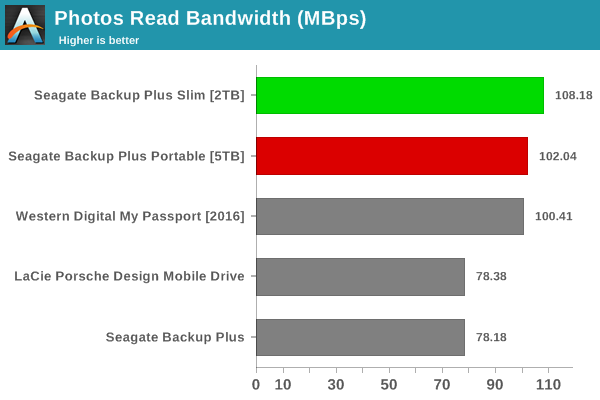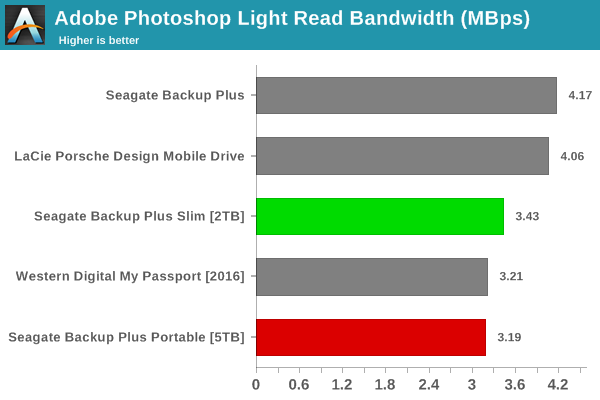Seagate Backup Plus Portable 5TB & Backup Plus Slim 2TB Review: SMR for the Consumer Market
by Ganesh T S on June 18, 2019 8:00 AM ESTDirect-Attached Storage Benchmarks
Our evaluation routine for hard-drive based direct-attached storage devices borrows heavily from the testing methodology for flash-based direct-attached storage devices. The testbed hardware (the Thunderbolt 3 / USB 3.1 Gen 2 Type-C port enabled by the Alpine Ridge host controller in the Hades Canyon NUC) is reused. CrystalDiskMark is used for a quick performance overview. Real-world performance testing is done with our custom test suite involving robocopy bencharks and PCMark 8's storage bench.
CrystalDiskMark uses four different access traces for reads and writes over a configurable region size. Two of the traces are sequential accesses, while two are 4K random accesses. Internally, CrystalDiskMark uses the Microsoft DiskSpd storage testing tool. The 'Seq Q32T1' sequential traces use 128K block size with a queue depth of 32 from a single thread, while the '4K Q32T1' ones do random 4K accesses with the same queue and thread configurations. The plain 'Seq' traces use a 1MiB block size. The plain '4K' ones are similar to the '4K Q32T1' except that only a single queue and single thread are used.
Comparing the '4K Q32T1' and '4K' numbers can quickly tell us whether the storage device supports NCQ (native command queuing) / UASP (USB-attached SCSI protocol). If the numbers for the two access traces are in the same ballpark, NCQ / UASP is not supported. This assumes that the host port / drivers on the PC support UASP. We can see that the Seagate Backup Plus external storage drives do support NCQ and UASP. Performance numbers are typical of what one might expect from a 5400 RPM hard drive, with peak performance close to 150 MBps for the 5TB Backup Plus Portable and around 135 MBps for the 2TB Backup Plus Slim.
| HDD-Based Direct-Attached Storage Benchmarks - CrystalDiskMark | ||
 |
 |
|
Moving on to the real-world benchmarks, we first look at the results from our custom robocopy test. In this test, we transfer three folders with the following characteristics.
- Photos: 15.6 GB collection of 4320 photos (RAW as well as JPEGs) in 61 sub-folders
- Videos: 16.1 GB collection of 244 videos (MP4 as well as MOVs) in 6 sub-folders
- BR: 10.7 GB Blu-ray folder structure of the IDT Benchmark Blu-ray (the same that we use in our robocopy tests for NAS systems)
The test starts off with the Photos folder in a RAM drive in the testbed. robocopy is used with default arguments to mirror it onto the storage drive under test. The content on the RAM drive is then deleted. robocopy is again used to transfer the content, but, from the storage drive under test to the RAM drive. The first segment gives the write speed, while the second one gives the read speed for the storage device. The segments end with the purge of the contents from the storage device. This process is repeated thrice and the average of all the runs is recorded as the performance number. The same procedure is adopted for the Videos and the BR folders.

The 5TB Backup Plus Portable comes out on top in a couple of workloads, as does the 2TB Backup Plus Slim. However, the relative positions across different workloads are not consistent. This indicates that performance consistency under sustained traffic is not predictable for these drives.
High-performance external storage devices can also be used for editing multimedia files directly off the unit. They can also be used as OS-to-go boot drives. Evaluation of this aspect is done using PCMark 8's storage bench. The storage workload involves games as well as multimedia editing applications. The command line version allows us to cherry-pick storage traces to run on a target drive. We chose the following traces.
- Adobe Photoshop (Light)
- Adobe Photoshop (Heavy)
- Adobe After Effects
- Adobe Illustrator
Usually, PC Mark 8 reports time to complete the trace, but the detailed log report has the read and write bandwidth figures which we present in our performance tables. Note that the bandwidth number reported in the results don't involve idle time compression. Results might appear low, but that is part of the workload characteristic. Note that the same CPU is being used for all configurations. Therefore, comparing the numbers for each trace should be possible across different DAS units.

The lack of performance consistency is more pronounced in these benchmarks. In fact, the two drives being reviewed today appear in the bottom half of the graphs more often than not. The reason for this requires deeper investigation into SMR characteristics, and this is presented in the next section.










62 Comments
View All Comments
StevoLincolnite - Tuesday, June 18, 2019 - link
Pass... It's a Seagate.Would be nice to get more mechanical disk benchmarks happening though, especially some of the larger 8-10TB+ drives.
MrSpadge - Tuesday, June 18, 2019 - link
Yeah, I've also seen at least one Seagate drive die. Never ever should anyone buy them again!29a - Tuesday, June 18, 2019 - link
If you're in it long enough you'll see all brands die.Death666Angel - Tuesday, June 18, 2019 - link
I think MS was being sarcastic by indulging in SLs nonsense comment.StevoLincolnite - Tuesday, June 18, 2019 - link
Not a nonsense comment.Nor did I mention anything about reliability... That was just an assumption by MrSpadge.
Oliseo - Sunday, June 23, 2019 - link
Here's the thing, the English language is such that you don't have to literally mention reliability for everyone to know that's exactly what you were talking about.Or are you now claiming everyone else was wrong to infer what you implied? In which case, the onus is on you to be more explicit in future to what you're actually talking about.
StevoLincolnite - Monday, June 24, 2019 - link
Rubbish Oliseo.Then again, if people automatically assumed I was talking about the drives reliability, maybe that just says everything about Seagates track record?
I was actually talking about warranty, or lack there-of here... I don't want to have to send anything overseas for replacement/repair.
eek2121 - Tuesday, June 18, 2019 - link
I have some hard drives that would like to disagree with you. Including a 10 MB one. MB. Not GB.Henry 3 Dogg - Sunday, January 30, 2022 - link
unless you made it yourself, I've seen a drive of that brand dieeek2121 - Tuesday, June 18, 2019 - link
I had the 5 GB drive die after 3 months of use. No more seagate for me. Loved the form factor though. These drives are small.